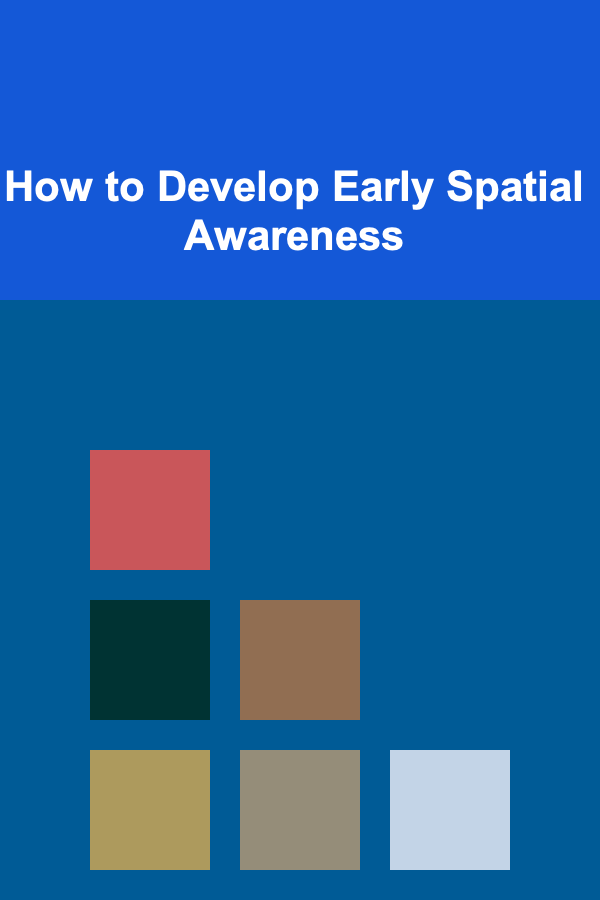
How to Develop Early Spatial Awareness
ebook include PDF & Audio bundle (Micro Guide)
$12.99$6.99
Limited Time Offer! Order within the next:

Spatial awareness is the ability to understand and navigate the spaces around us. It plays an essential role in our ability to move through the world, interact with our environment, and perform daily tasks. Developing early spatial awareness is crucial for young children, as it sets the foundation for future learning and development. It helps in areas such as physical coordination, academic learning, social interactions, and problem-solving. This article explores how spatial awareness develops in children, why it's important, and strategies for fostering this skill in early childhood.
The Importance of Spatial Awareness
Spatial awareness is not just about understanding where objects are located in space; it also involves understanding how those objects move and how we, as individuals, fit into that space. Spatial awareness includes several key components:
- Position and Direction: Understanding where things are in relation to oneself and others.
- Distance and Size: Recognizing the size of objects and how far apart they are.
- Movement and Motion: Understanding how objects move in space and how one's body moves in relation to those objects.
- Balance and Coordination: Being able to move fluidly and adjust posture while interacting with the environment.
In early childhood, spatial awareness is a precursor to other important skills, including motor development, cognitive growth, and social interactions. It is closely related to a child's ability to learn math, read maps, and engage in problem-solving. When children have a strong sense of spatial awareness, they are more confident in navigating their world and interacting with others.
How Spatial Awareness Develops in Children
Spatial awareness is not an innate skill but one that develops over time as children grow and interact with their environment. It begins in infancy and continues to evolve throughout childhood. The development of spatial awareness can be broken down into several stages:
Infancy (0-12 months)
During the first year of life, babies begin to develop a basic understanding of spatial concepts. Initially, this awareness is rudimentary and is based primarily on visual and tactile input. For example, babies may start to track objects with their eyes or reach for items just out of their reach. As babies move through space by crawling, they start to understand concepts like directionality, such as moving toward a parent or toy.
Toddlerhood (1-3 years)
By the time children reach toddlerhood, their spatial awareness becomes more refined. They begin to navigate their environment with increasing coordination, such as walking, running, and climbing. They start to understand concepts such as "near" and "far" and can grasp simple ideas like positioning and relative distance. During this stage, toddlers also begin to understand basic geometric shapes and can identify simple patterns and sizes.
Preschool Years (3-5 years)
As children approach preschool age, their spatial awareness becomes more sophisticated. They start to understand more complex concepts such as up, down, left, right, and behind. They can navigate through obstacles, understand how objects fit together, and can follow simple directions like "put the red block on top of the blue block."
At this stage, children also develop an awareness of their body in space. They start to engage in activities that require fine and gross motor skills, such as riding a tricycle, stacking blocks, or drawing shapes. These activities help reinforce spatial awareness and coordination.
Early School Years (5-7 years)
In the early school years, children's spatial awareness continues to develop as they begin to engage in activities that require more complex spatial thinking. They are able to solve puzzles, use maps, and understand concepts such as symmetry, rotations, and spatial relationships. They begin to demonstrate an understanding of three-dimensional space and are able to manipulate objects in space more efficiently.
By the time children reach this stage, their ability to understand direction, scale, and distance is critical for academic learning, particularly in subjects like math, science, and geography.
Factors That Influence Spatial Awareness Development
Several factors contribute to how well a child develops spatial awareness. These factors can vary based on the child's environment, experiences, and individual abilities.
1. Physical Activity
Physical activity plays a significant role in developing spatial awareness. Activities like running, climbing, and dancing allow children to explore their environment and gain a better understanding of their body's position in space. By engaging in physical activities, children develop balance, coordination, and motor skills, all of which are crucial for building spatial awareness.
2. Environmental Interaction
Children who have the opportunity to explore a variety of environments are more likely to develop strong spatial awareness. For instance, outdoor play in parks, forests, or urban spaces provides children with real-world opportunities to practice navigating through different types of spaces. Additionally, play areas that encourage climbing, jumping, or problem-solving, such as obstacle courses, can help children develop a better understanding of how objects and spaces relate to one another.
3. Technology and Screen Time
While physical play is essential for developing spatial awareness, technology can also play a role. Educational games, apps, and virtual reality experiences that require children to navigate spaces or manipulate objects in a digital environment can help improve their spatial skills. However, it is important to balance screen time with physical activity to ensure a well-rounded development of spatial awareness.
4. Family and Social Interactions
Parents and caregivers play an important role in developing a child's spatial awareness. Children learn by watching and interacting with those around them, and caregivers can support spatial development by providing opportunities for spatially engaging activities, such as playing with blocks, drawing, and playing games that involve directionality or positioning.
Social interactions with peers also contribute to spatial awareness. Children learn to navigate social spaces, understand personal boundaries, and cooperate in activities that require an understanding of physical space.
5. Cultural Influences
Cultural differences can impact how spatial awareness is developed and valued. For example, some cultures may place more emphasis on outdoor exploration and physical play, while others may focus on structured activities that teach spatial reasoning through puzzles or games. These cultural influences can shape how children learn about and interact with the world around them.
Strategies for Developing Spatial Awareness
There are several ways to support and encourage the development of spatial awareness in young children. Here are some effective strategies:
1. Encourage Active Play
Physical activity is essential for developing spatial awareness. Encourage children to engage in activities that promote body movement and coordination, such as:
- Climbing: Provide access to climbing structures that challenge children to navigate up, down, and across different heights.
- Running and Jumping: Activities like running, hopping, or jumping help children develop awareness of space and distance.
- Balance: Activities like walking on a balance beam or playing balance games promote spatial awareness and body control.
2. Play with Blocks and Building Toys
Building with blocks, Legos, or other construction toys is an excellent way for children to develop spatial skills. These activities help children understand how different shapes fit together, how to create symmetrical structures, and how to solve problems related to space. You can encourage children to build towers, bridges, or other structures, prompting them to consider space, size, and shape.
3. Use Maps and Simple Directions
Introducing maps or giving children simple directions can help improve their understanding of spatial concepts. You can start by showing them simple maps of their home, neighborhood, or school. As they become familiar with these maps, you can ask them to follow directions such as "Go straight, then turn left" or "The park is behind the school."
4. Engage in Puzzle Solving
Puzzles, particularly jigsaw puzzles, are excellent tools for developing spatial awareness. They require children to think about how pieces fit together and how to rotate or move them to complete the image. As children work through puzzles, they are reinforcing their understanding of shapes, sizes, and relationships between objects.
5. Incorporate Art and Drawing
Drawing and other art activities encourage children to think about spatial relationships and symmetry. Ask children to draw shapes, maps, or scenes, encouraging them to think about how objects relate to each other in space. Drawing shapes from different angles or creating 3D art projects can help develop a child's spatial reasoning.
6. Play Movement and Direction Games
Games that involve directionality, such as "Simon Says," "Follow the Leader," or obstacle courses, are great for teaching children about space and movement. These games require children to think about their position in space, as well as their relationship to other people and objects. You can also incorporate directional language such as "left," "right," "over," "under," and "around."
7. Foster Everyday Problem-Solving
Everyday tasks can also provide opportunities for children to develop spatial awareness. For example, cooking together in the kitchen can help children understand measurements, distances, and volume. Organizing toys or cleaning up can also require them to think about how to arrange and categorize objects based on size and space.
Conclusion
Developing early spatial awareness is essential for children's overall development, helping them build motor skills, cognitive abilities, and social skills. Spatial awareness influences a child's ability to learn math, engage in physical activity, and understand their environment. Through active play, exploration, and interaction with caregivers and peers, children can develop strong spatial awareness that will serve them throughout their lives. By incorporating strategies such as playing with blocks, engaging in puzzle-solving, and practicing movement games, parents and educators can foster spatial skills in young children, setting them up for success in a variety of academic and social areas.

Creative Tips for Cutting Back on Eating Out Without Sacrificing Flavor
Read More
How to Choose the Right Bulb for Different Lighting Needs in Your Home
Read More
How to Organize Your Kitchen Cabinets for Maximum Storage Capacity
Read More
How to Prevent Clogged Drains with Simple Maintenance Tips
Read More
How to Stay Motivated While Learning a New Skill
Read More
Choosing the Best Stand-Up Comedy Specials: A Comprehensive Guide
Read MoreOther Products

Creative Tips for Cutting Back on Eating Out Without Sacrificing Flavor
Read More
How to Choose the Right Bulb for Different Lighting Needs in Your Home
Read More
How to Organize Your Kitchen Cabinets for Maximum Storage Capacity
Read More
How to Prevent Clogged Drains with Simple Maintenance Tips
Read More
How to Stay Motivated While Learning a New Skill
Read More